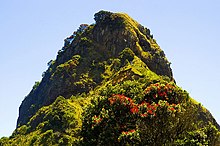Waitakere Ranges
| Waitakere Ranges | ||
|---|---|---|
| Highest peak | Te Toiokawharu ( 474 m ) | |
| location | Auckland Region , North Island , New Zealand | |
|
|
||
| Coordinates | 36 ° 56 ′ S , 174 ° 32 ′ E | |
The Waitakere Ranges ( Māori Te Wao nui a Tiriwa ) are a range of hills that extend about 25 km west of Auckland in New Zealand over a distance of 25 km in a north-south direction. They are a maximum of 474 meters high.
The west coast west of Auckland consists of cliffs up to 300 meters high, which are occasionally interrupted by beaches. The cliffs were formed by erosion from ancient volcanic conglomerate and lava flows that were deposited 12 to 25 million years ago. The hills are covered by "bush" (in this case subtropical forest) that regenerated after deforestation and agriculture in the second half of the 18th and early 19th centuries.
In 1894 a group led by Sir Algernon Thomas , the first professor of geology and botany at the University of Auckland , succeeded in convincing the Auckland City Council to recognize 14 km² in the Nihotupu area of the Waitakere Ranges as a protected area. In 1895 the New Zealand government classified this area and several other, smaller parts of the Waitakere Ranges as "Reserves for the Conservation of Native Flora and Fauna". The Reserve of The Waitakere Ranges Regional Parkland now covers an area of approximately 160 km².
There are five reservoirs within the ranges that were built to supply water to the Auckland region. There is over 2000mm of annual rainfall here, while Auckland receives less than half of that. Since the weather systems come from the Tasman Sea , their path is blocked by the Waitakere Ranges, which are high enough to cause the clouds to rain down.
The only access to the resorts of Piha and Karekare is through the mountains .
In the ranges there are cowries and so-called glowworms ( Arachnocampa luminosa , not to be confused with the German glowworms ), wetas and New Zealand bats . Poles of the genus Peripatus , of which egg-laying specimens with 14 pairs of legs and ovioviviparous specimens with 15 or 16 pairs of legs, which do not belong to any of the five scientifically described New Zealand species, are found in the area.
At the north end at Otakamiro Point is one of the few booby breeding colonies on mainland New Zealand.
The coast in front of the range of hills has four beaches popular for surfing, Muriwai Beach , Te Henga , Piha and Karekare. The ranges also offer an extensive network of walking and driving trails and beautiful views of the east and west coasts and Auckland. A road called Scenic Drive runs from Titirangi to Swanson through much of the Ranges. The Auckland City Council operates an information center near Titirangi.
The beaches are as many beaches of the west coast north of the region Taranaki s of black volcanic sand. They are dangerous for swimmers because of the back currents of the surf and strong swell .
Web links
- Society for the Protection of the Waitakere ranges (English)
- Waitakere Ranges . Auckland Council,accessed January 10, 2016.


